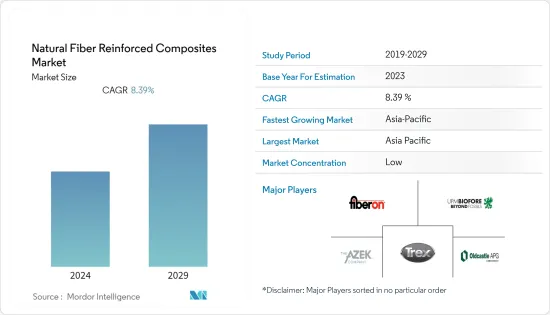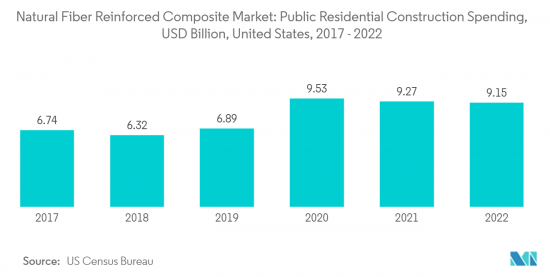 |
市場調査レポート
商品コード
1403978
天然繊維強化複合材料:市場シェア分析、産業動向と統計、2024年~2029年の成長予測Natural Fiber Reinforced Composites - Market Share Analysis, Industry Trends & Statistics, Growth Forecasts 2024 - 2029 |
||||||
● お客様のご希望に応じて、既存データの加工や未掲載情報(例:国別セグメント)の追加などの対応が可能です。 詳細はお問い合わせください。
| 天然繊維強化複合材料:市場シェア分析、産業動向と統計、2024年~2029年の成長予測 |
|
出版日: 2024年01月04日
発行: Mordor Intelligence
ページ情報: 英文 125 Pages
納期: 2~3営業日
|
- 全表示
- 概要
- 目次
天然繊維強化複合材料市場は、2024年の4,081.05キロトンから2029年には6,104.85キロトンに成長し、予測期間中のCAGRは8.39%を記録すると予測されています。

主なハイライト
- 中期的には、バイオベースのコンポジット需要の増加や、エレクトロニクス産業における環境に優しいコンポジット需要の増加といった要因が、天然繊維強化複合材料市場を牽引するであろう。
- しかし、水分の吸着、加工温度の制限、ほとんどのポリマーマトリックスとの非相溶性、ガラス繊維強化複合材料に比べて低い耐衝撃性などが、市場の抑制要因になると思われます。
- とはいえ、天然繊維強化ポリマー複合材料の難燃性は、市場に新たな機会をもたらすと期待されています。
- アジア太平洋地域が市場を独占しており、予測期間中に最も高いCAGRで推移する可能性が高いです。この成長は、建設産業への支出が急速に増加していることに起因しています。
天然繊維強化複合材料市場の動向
建設部門からの需要の増加
- 建築材料業界では、環境に優しい材料が常に求められています。天然繊維強化ポリマーをベースとした複合材料は、その多くの利点から、土木建築用途での使用が増加しています。
- 建築・建設業界において、複合材料は極めて重要な役割を担っています。産業用支柱、タンク、ロングスパンの屋根構造、タンク、高層ビル、軽量ドア、窓、家具、軽量ビル、橋梁部品、橋梁システム一式など、すべて複合材料が採用されています。複合材料は、長期的な持続可能性を達成する手段として、建設業界においてますます不可欠になってきています。
- 建設部門では近年、大規模な投資が行われています。オックスフォード・エコノミクスによると、世界の建設産業は2020年から2030年の間に4兆5,000億米ドル(42%)成長し、15兆2,000億米ドルに達すると予想されています。また、中国、インド、米国、インドネシアは、2020年から2030年にかけての世界の建設業成長の58.3%を占めると予想されています。
- 北米では、米国が建設業界で大きなシェアを占めています。米国のほか、カナダとメキシコも建設部門への投資に大きく貢献しています。米国国勢調査局データによると、米国の公共住宅建設の年間金額は2022年に91億5,000万米ドルと評価され、2017年の67億4,000万米ドルに比べ35.7%増加しました。
- 同様に、欧州の建設部門は、EU復興基金からの新規投資により、2022年に2.5%成長しました。EUのほとんどの建設会社で価格圧力がかかっているにもかかわらず、景況感は2022年初めに回復し、COVID-19以前の水準に達すると予想されます。さらに、COVID-19による危機が和らぐにつれて、建設業者は新しい社屋への投資や既存物件の改修に消極的になります。
- したがって、前述の動向は予測期間中、建設分野における天然繊維強化複合材料の成長に影響を与えると予測されます。

市場を独占するアジア太平洋地域
- アジア太平洋地域が世界市場を独占すると予想されます。中国、インド、日本などの国々で建設活動が活発化しているため、この地域では天然繊維強化複合材料の使用量が増加しています。
- 建設部門は、中国の継続的な経済発展の主な担い手です。中国国家統計局によると、建設生産額は2021年の29兆3,000億人民元(4兆2,000億米ドル)から2022年には31兆2,000億人民元(4兆5,000億米ドル)に増加します。中国は、2030年までに建築物に13兆米ドル近くを投じると予想されており、天然繊維強化複合材料にとって明るい見通しとなっています。
- 住宅都市農村開発省によると、中国の建設部門は2025年までGDPの6%を維持すると予想されています。この予測を踏まえ、中国政府は2022年1月、建設部門をより持続可能で品質主導のものにすることを主眼とした5カ年計画を発表しました。
- 同様に、天然繊維強化複合材料のエレクトロニクス産業への応用が急増していることも、同国の産業成長を下支えする可能性が高いです。インド・ブランド・エクイティ財団(IBEF)によると、インドの電子機器製造業は2025年までに5,200億米ドルに達すると予想されています。
- さらに、自動車は天然繊維強化複合材料の主要な消費者のひとつです。インドの自動車産業は、技術進歩とマクロ経済の拡大の両面で重要な役割を果たしているため、インド経済の業績を示す重要な指標となっています。
- さらに、インド政府は、2030年までに電気自動車(EV)の普及率30%を目指す「(ハイブリッド車と)電気自動車の迅速な導入と製造(Faster Adoption and Manufacturing of(Hybrid and)Electric Vehicles)」計画を通じて、電気自動車の導入を奨励し、一部の分野では義務付ける勢いを生み出しています。この計画は、EVに対する需要インセンティブを創出し、都市中心部への充電技術とステーションの配備を支援するものです。政府は、2030年までにインドで販売される商用車の70%、自家用車の30%、バスの40%、二輪車と三輪車の80%を電気自動車にするという目標を掲げています。
- したがって、さまざまな政府による新しい政策や投資は、予測期間中にその他アジア太平洋地域の天然繊維強化複合材料市場の需要を押し上げると予想されます。
天然繊維強化複合材料産業の概要
天然繊維強化複合材料市場は断片化されており、大きな市場シェアを獲得している企業はいないです。市場の主要企業(順不同)には、Trex Company Inc.、Fiberon Technologies Inc.、UPM-Kymmene Oyj、The AZEK Company、Oldcastle APGなどが含まれます。
その他の特典:
- エクセル形式の市場予測(ME)シート
- 3ヶ月間のアナリスト・サポート
目次
第1章 イントロダクション
- 調査の前提条件
- 調査範囲
第2章 調査手法
第3章 エグゼクティブサマリー
第4章 市場力学
- 促進要因
- バイオベース複合材料の需要増加
- 世界の自動車産業の成長
- 抑制要因
- 水分吸着、加工温度の制限、大半のポリマーマトリックスとの非相溶性
- 外部環境への暴露による劣化問題
- 業界バリューチェーン分析
- ポーターのファイブフォース分析
- 供給企業の交渉力
- 消費者の交渉力
- 新規参入業者の脅威
- 代替品の脅威
- 競合の程度
第5章 市場セグメンテーション(数量ベース市場規模)
- 繊維
- 木材繊維複合材料
- 非木材繊維複合材料
- 綿
- 亜麻
- ケナフ
- 麻
- その他の非木材繊維複合材料
- ポリマー
- 熱硬化性樹脂
- 熱可塑性プラスチック
- ポリエチレン
- ポリプロピレン
- ポリ塩化ビニル
- その他の熱可塑性プラスチック
- エンドユーザー産業
- 航空宇宙
- 自動車
- 建築・建設
- 電気・電子
- スポーツ
- その他のエンドユーザー産業
- 地域
- アジア太平洋
- 中国
- インド
- 日本
- 韓国
- その他のアジア太平洋
- 北米
- 米国
- カナダ
- メキシコ
- 欧州
- ドイツ
- 英国
- イタリア
- フランス
- その他の欧州
- 南米
- ブラジル
- アルゼンチン
- その他の南米
- 中東・アフリカ
- サウジアラビア
- 南アフリカ
- その他の中東・アフリカ
- アジア太平洋
第6章 競合情勢
- M&A、合弁事業、提携、協定
- 市場シェアランキング分析
- 主要企業の戦略
- 企業プロファイル
- Amorim Cork Composites SA
- Fiberon Technologies Inc.
- FlexForm Technologies
- Green Dot Bioplastics Inc.
- GreenGran BN
- Jelu-Werk Josef Ehrler GmbH & Co. Kg
- Meshlin Composites ZRT
- NPSP NV
- Oldcastle APG
- Polyvlies Franz Beyer GmbH & Co. Kg
- Tecnaro GmbH
- The AZEK Company
- Trex Company Inc.
- TTS
- UPM-Kymmene Oyj
第7章 市場機会と今後の動向
- 建築・建設業界における人気の高まり

The natural fiber reinforced composites market is expected to grow from 4,081.05 kilo tons in 2024 to 6,104.85 kilo tons by 2029, registering a CAGR of 8.39% during the forecast period.
Key Highlights
- Over the medium term, factors such as the increasing demand for bio-based composites and the growing demand for eco-friendly composites in the electronics industry would drive the natural fiber-reinforced composites market.
- However, the moisture adsorption, restricted processing temperature, incompatibility with most polymer matrices, and lower impact resistivity compared to glass fiber-reinforced composites are likely to act as restraints for the market.
- Nevertheless, the flame retardancy of natural fiber-reinforced polymer composites is expected to provide new opportunities for the market.
- The Asia-Pacific region dominates the market and is likely to witness the highest CAGR during the forecast period. This growth is attributed to the rapid rise in expenditure on the construction industry.
Natural Fiber Reinforced Composites Market Trends
Increasing Demand from the Construction Sector
- There is always a continuous requirement for eco-friendly materials in the building materials industry. Natural fiber-reinforced polymer-based composites are increasingly used in civil engineering construction applications due to their numerous advantages.
- In the building and construction industry, composite materials are extremely significant. Industrial supports, tanks, long-span roof structures, tanks, high-rise buildings and lightweight doors, windows, furnishings, lightweight buildings, bridge components, and complete bridge systems have all employed composite materials. Composite materials are becoming increasingly essential in the construction industry as a means of achieving long-term sustainability.
- The construction sector has witnessed major investments in recent years. According to Oxford Economics, the global construction industry is expected to grow by USD 4.5 trillion, or 42%, between 2020 and 2030 to reach USD 15.2 trillion. Also, China, India, the United States, and Indonesia are expected to account for 58.3% of global growth in construction between 2020 and 2030.
- In North America, the United States has a major share in the construction industry. Besides the United States, Canada and Mexico contribute significantly to investments in the construction sector. According to the United States Census Bureau Data, the annual value of public residential construction in the United States was valued at USD 9.15 billion in 2022, an increase of 35.7% compared to USD 6.74 billion in 2017.
- Similarly, the European construction sector grew by 2.5% in 2022 due to new investments from the EU Recovery Fund. Business confidence picked up in early 2022, despite price pressures at most EU construction firms, and is expected to reach pre-COVID-19 levels. Moreover, as the crisis due to COVID-19 abates, builders become less reluctant to invest in new corporate buildings and renovate existing properties.
- Hence, the aforementioned trends are projected to influence the growth of natural fiber-reinforced composites in the construction sector over the forecast period.

Asia-Pacific Region to Dominate the Market
- The Asia-Pacific region is expected to dominate the global market. With growing construction activities in countries such as China, India, and Japan, the usage of natural fiber-reinforced composites is increasing in the region.
- The construction sector is a key player in China's continued economic development. According to the National Bureau of Statistics of China, the value of construction output accounted for CNY 31.2 trillion (USD 4.5 trillion) in 2022, up from CNY 29.3 trillion (USD 4.2 trillion) in 2021. China is expected to spend nearly USD 13 trillion on buildings by 2030, creating a positive outlook for natural fiber-reinforced composites.
- As per the Ministry of Housing and Urban-Rural Development, China's construction sector is expected to maintain a 6% share of the country's GDP going into 2025. Keeping in view the given forecasts, the Chinese government unveiled a five-year plan in January 2022 focused on making the construction sector more sustainable and quality-driven.
- Similarly, the surging application of natural fiber-reinforced composites in the electronics industry is likely to support the industry growth in the country. According to the India Brand Equity Foundation (IBEF), the Indian electronics manufacturing industry is expected to reach USD 520 billion by 2025.
- Furthermore, automotive is among the major consumers of natural fiber-reinforced composites. The automotive industry in India is an important indicator of the Indian economic performance, as this sector plays a vital role in both technological advancements and macroeconomic expansion.
- Additionally, the Indian government has created momentum through its Faster Adoption and Manufacturing of (Hybrid and) Electric Vehicles schemes that encourage, and in some segments, mandate the adoption of electric vehicles (EV), intending to reach 30% EV penetration by 2030. The scheme creates demand incentives for EVs and supports the deployment of charging technologies and stations in urban centers. The government has set a target of 70% of all commercial cars, 30% of private cars, 40% of buses, and 80% of two-wheelers and three-wheelers sold in India by 2030 to be electric.
- Hence, the new policies and investments made by different governments are expected to boost the demand for the natural fiber-reinforced composites market in the rest of Asia-Pacific during the forecast period.
Natural Fiber Reinforced Composites Industry Overview
The natural fiber-reinforced composites market is fragmented, with no player capturing a significant market share. The major players in the market (in no particular order) include Trex Company Inc., Fiberon Technologies Inc., UPM-Kymmene Oyj, The AZEK Company, and Oldcastle APG, among others.
Additional Benefits:
- The market estimate (ME) sheet in Excel format
- 3 months of analyst support
TABLE OF CONTENTS
1 INTRODUCTION
- 1.1 Study Assumptions
- 1.2 Scope of the Study
2 RESEARCH METHODOLOGY
3 EXECUTIVE SUMMARY
4 MARKET DYNAMICS
- 4.1 Drivers
- 4.1.1 Increasing Demand for Bio-based Composites
- 4.1.2 Growth in Automotive Industry Worldwide
- 4.2 Restraints
- 4.2.1 Moisture Adsorption, Restricted Processing Temperature, and Incompatibility with Most Polymer Matrices
- 4.2.2 Degradation Issue Due to Exposure to the External Environment
- 4.3 Industry Value Chain Analysis
- 4.4 Porter's Five Forces Analysis
- 4.4.1 Bargaining Power of Suppliers
- 4.4.2 Bargaining Power of Consumers
- 4.4.3 Threat of New Entrants
- 4.4.4 Threat of Substitute Products and Services
- 4.4.5 Degree of Competition
5 MARKET SEGMENTATION (Market Size by Volume)
- 5.1 Fiber
- 5.1.1 Wood Fiber Composites
- 5.1.2 Non-wood Fiber Composites
- 5.1.2.1 Cotton
- 5.1.2.2 Flax
- 5.1.2.3 Kenaf
- 5.1.2.4 Hemp
- 5.1.2.5 Other Non-wood Fiber Composites
- 5.2 Polymer
- 5.2.1 Thermosets
- 5.2.2 Thermoplastics
- 5.2.2.1 Polyethylene
- 5.2.2.2 Polypropylene
- 5.2.2.3 Poly Vinyl Chloride
- 5.2.2.4 Other Thermoplastics
- 5.3 End-user Industry
- 5.3.1 Aerospace
- 5.3.2 Automotive
- 5.3.3 Building and Construction
- 5.3.4 Electrical and Electronics
- 5.3.5 Sports
- 5.3.6 Other End-user Industries
- 5.4 Geography
- 5.4.1 Asia-Pacific
- 5.4.1.1 China
- 5.4.1.2 India
- 5.4.1.3 Japan
- 5.4.1.4 South Korea
- 5.4.1.5 Rest of Asia-Pacific
- 5.4.2 North America
- 5.4.2.1 United States
- 5.4.2.2 Canada
- 5.4.2.3 Mexico
- 5.4.3 Europe
- 5.4.3.1 Germany
- 5.4.3.2 United Kingdom
- 5.4.3.3 Italy
- 5.4.3.4 France
- 5.4.3.5 Rest of Europe
- 5.4.4 South America
- 5.4.4.1 Brazil
- 5.4.4.2 Argentina
- 5.4.4.3 Rest of South America
- 5.4.5 Middle East and Africa
- 5.4.5.1 Saudi Arabia
- 5.4.5.2 South Africa
- 5.4.5.3 Rest of Middle East and Africa
- 5.4.1 Asia-Pacific
6 COMPETITIVE LANDSCAPE
- 6.1 Mergers and Acquisitions, Joint Ventures, Collaborations, and Agreements
- 6.2 Market Share Ranking Analysis
- 6.3 Strategies Adopted by Leading Players
- 6.4 Company Profiles
- 6.4.1 Amorim Cork Composites SA
- 6.4.2 Fiberon Technologies Inc.
- 6.4.3 FlexForm Technologies
- 6.4.4 Green Dot Bioplastics Inc.
- 6.4.5 GreenGran BN
- 6.4.6 Jelu-Werk Josef Ehrler GmbH & Co. Kg
- 6.4.7 Meshlin Composites ZRT
- 6.4.8 NPSP NV
- 6.4.9 Oldcastle APG
- 6.4.10 Polyvlies Franz Beyer GmbH & Co. Kg
- 6.4.11 Tecnaro GmbH
- 6.4.12 The AZEK Company
- 6.4.13 Trex Company Inc.
- 6.4.14 TTS
- 6.4.15 UPM-Kymmene Oyj
7 MARKET OPPORTUNITIES AND FUTURE TRENDS
- 7.1 Increasing Popularity in the Building and Construction Industry
